|
FAQs about Live Rock Hitchhiker/Creature
Identification
18
Related Articles: Live
Rock, Reef Systems, Refugiums,
Related FAQs: Live Rock, Answering
Some LR FAQs by James Fatherree, LR
Hitchhiker ID 1, LR Hitchhiker ID
2, LR Hitchhiker ID 3, LR Hitchhiker ID 4, LR Hitchhiker ID
5, LR ID
6, LR ID
7, LR ID 8, LR ID 9, LR ID
10, LR ID
11, LR ID 12,
LR ID 13,
LR ID 14,
LR ID 15,
LR ID 16,
LR ID17,
LRID
19,
LRID
20, LRID 21, LRID 22,
LRID 23, LRID 24, LRID 25,
LRID 27,
LRID 28,
LRID 29,
LRID 30,
LRID 31,
LRID 32,
LRID 33,
LRID 34,
LRID 35,
LRID 36,
LRID 37,
LRID 38,
&
Non-Vert IDs 1, Tubeworm ID, Polychaete Identification, Live Rock 1, LR 2,
LR 3, LR 4,
LR 5, Curing
Live Rock, Live Rock Selection,
Shipping/Moving, Placement, Lighting, Water Quality, Live Rock Studies in Fiji Collaboration
& Charts, Copper Use, Marine
Landscaping, Marine Biotope,
Sumps, Refugiums, Faux
Rock,
|
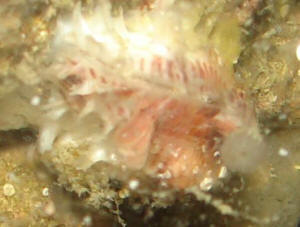
|
Re: Florida Liverock and the unsuspecting Novice... Shades
of Doug Adams' Hitchhiker's Guide..." "Sir, HHs...
Hmmmm"> 04/02/09
Bob (or other crew member)
<Ave Marci>
I checked out the PowerPoint on hitchhikers you mentioned on your last
response and found it interesting. It would have been nice to be there
to hear the discussion to fill in some gaps, but it was interesting
nonetheless.
<Mmm, I do so wish that technology... or my grasp of what is likely
already available/application-wise here... was a bit further on. I have
given a few presentations (.ppt) on this topic/subject, some of which
were videotaped, including said discussions... I would post these for
review if I knew how><<Oh, and I will post the "article
version", after it runs in the pulp press... as usual>>
I also decided to use some of my monthly 'tank budget' to buy
your book, Conscientious Marine Aquarist. That should have come with
the tank. Its very informative and really geared to someone with my
level of experience, more so than the other books adorning the
bookcase.
<Is designed for beginner to intermediates... with enough (I hope)
lead ins to encourage folks going further>
Since I sent the last email, I've decided to go hunting in the tank
for some of these bad critters. In the last 2 weeks, I've used
various methods including water bottle traps, clear glass with food in
the bottom, commercial traps, and even using fishing line with some
bait on it to lure unsuspecting critters out of the rock so I could
pick them off with tongs; which is my favorite - instant
gratification!.
<Heeee! Oft cited as a "western" trait, methinks this
encompasses all humans, perhaps I'll venture a bit further and say
all Primates>
In addition to the multitudes of critters I've taken out over the
last 9 months since getting the rock, I caught 13 xanthid crabs
(I'm using the term generically here for any crab that's hairy,
black-clawed, and downright ornery),
<Good desc.>
removed 10 more whelks - Gemophos tinctus, I believe, and one small
mantis shrimp. Last night, I saw my
lovely Eunicid worm attacking a serpent star once again and decided it
had to go.
<"Go go Godzilla">
It required moving half the live rock to the other side of the tank and
some digging in the sandbed, but I was successful. I had only seen
about 6 inches of this worm at any one time before, but now that its
out, it measures over 2 feet!
<Now that's a worm! Leto III?>
So, the tank is more peaceful, but I still have crabs I don't want
in there - the ones I can see, at least, seem a bit smarter than the
others - and perhaps a bit smarter than me. I've also seen 2 more
Eunicid worms that may or may not be good, may or may not grow to
2'+ in length. The tank still clicks and pops, I've got more
mantis in there or pistol shrimp - which I understand also may or may
not be good. And given the number of whelks I've found, and the
small size of some, I'd say they reproduced and many more are in
there somewhere.
<A possibility for sure>
As I mentioned previously, I'm fairly patient, and I haven't
purchased any livestock for the tank in the way of corals or other
sessile inverts. I've only got the 3 anemones and gorgonian that
came with the rock in there. So, I'm in a position where I can
break down the tank fairly easily and can move good critters to my
refugium or QT for a while if necessary.
<Good>
Since the tank seems to be overrun with nasties, and I don't feel
its fair to introduce more livestock into an environment where they
could potentially be food, what options do I have?
<Keeping up the predator (that's you) pressure>
I've read about freshwater dips for live rock to chase out bad
guys. What happens to the rock when I do this?
<Some other "stuff"/life gets stressed... hopefully not
too much>
Am I going to kill the good bacteria and coralline growing on it?
<Mmm, decidedly not... these are very tough, resilient... and if
only "some" is left somewhere in the system and conditions
are propitious, "they'll be baaaack">
I've also heard of just filling the tank with freshwater for a few
days, and pretty much starting over.
<Mmm, nah. Don't do this>
I'm OK with that if its my only option. I understand that
there's always the chance to introduce something in the future,
miss something no matter what level of effort I employ, and that
sometimes variety is just plain fun... But, I'd rather get my tank
to a known state, instead of adding new critters only to find out I
need to break down the live rock again to remove a 2' long
predatory worm, or watch my invert population slowly and inexplicably
dwindle.
Thank you again for all of the help!
<And you for communicating so well... T'were it me, mine,
I'd go ahead with whatever slow, steady stocking plan you're
devising... And not be overly concerned with the "nasties" as
you call them here... The universe is not as didactic as it is
oft-presented... in this case, there are always some undesireables
coming, going... best to be aware, vigilant, but otherwise take all in
stride, enjoy while, what you can... ignore as much as you can't
otherwise remove easily. Entiendes? BobF>
Live Rock Book? 3/16/09
hi my name is Liz ...
<Hello Liz, I see your "shift key" isn't working on
your PC.>
i was wondering if there is a book that shows the different types of
live rock and that really goes into depth on the microscopic organisms
that grow on them....??
<None that I am aware of that deal specifically on what you're
looking for.
Bob and other crew members may know of one.>
thanks....
<You're welcome. James (Salty Dog)>
|
Emailing: marine life 049, marine life 047, SW alg ID
3/15/09
Hi everyone, I'm a new at this - and totally intrigued by all
that grows on live rock! Can anyone identify this growth on my
live rock. Its growing in my Aquapod 24 gal with metal halide
light, which was set up for
4 months ago, and it appeared about two months ago - and growing.
Is it safe to leave in tank? Thanks. EG
Your message is ready to be sent with the following file or
link
attachments:
marine life 049
marine life 047
<Hello. This is a marine alga from the genus Padina, know
colloquially as "scroll algae". It is safe? Much like
any other alga, in small quantities it's attractive and
interesting, but if conditions favour the algae compared with
other encrusting organisms, it will take up the available
"ecological space" and can become a pest.
http://www.wetwebmedia.com/brnalgae.htm
Cheers, Neale.>
|
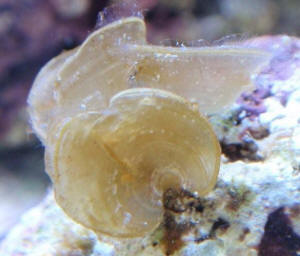 |
Re: Emailing: marine life 049, marine
life 047 3/16/09
Thanks Neal.
<Most welcome.>
I'll leave the 'scroll' algae in for now and keep
watching it for signs of 'invasion'. There are two groups
of three, about 3/4 of an inch high at present, and growing on a
piece of live rock that is detached from the main body of live rock
in the tank; would be easy to remove if the need arises.
Also, the day after I took these photos, I found a Turbo snail
eating part of one of the scrolls (good to know).
<Indeed! Sea urchins will also eat them.>
Again, thanks for the info! I'm a frequent visitor to Wet Web
Media , and I'm always impressed with your vast knowledge base!
EG
<Ah, in this case the benefit of having been a marine biologist
some time ago. Mostly a freshwater fishkeeper nowadays! Cheers,
Neale.> |
|
Miracle Mud And C-Balance Not Balanced 2/16/09 ID Of
Critters On Live Rock Hey guys, <Hello Steven> I
have a few questions for you and I would also like you to ID
something in my tank. Let me give you a tiny bit of background
before I get started. I have a 55 gallon reef right now and I
would like to upgrade to a 200 gallon reef when I move out :) . I
am making some changes in my 55 gallon reef to test out some new
things before I implement them on a larger scale. Right now I use
the Berlin method of filtration with an AquaC Remora Pro for
skimming, RowaPhos to remove the extra phosphates, and C-Balance
to keep the calcium and alkalinity in check. In my new tank I
would like to try to keep the maintenance cost down so I figured
why not try out for Miracle Mud'¦ I figured I could save
some money on C-balance and maybe not even use a calcium reactor.
Here is the problem: I put the Miracle Mud in the Aquafuge with
some Chaeto and reduced the amount of C-balance that I added by
around half. The calcium level is going up but the alkalinity is
going down. My calcium is around 470 and the alkalinity is around
2.8 mEq/L. I called Ecosystem and they said that the mud
won't boost the alkalinity as much as the calcium. I called
Two Little Fishes and asked them if I could use more of part B to
balance things out and they told me never to do that. They told
me to always add equal amounts of part A and B. I have been using
some reef buffer by Seachem to keep the alkalinity raised
instead. Is this a viable long term solution? Will I end up
problems down the line using the combination of C-balance,
Miracle Mud, and Reef Buffer? <This is one of the reasons I do
not like using Part A/B products. I'm for dosing a la carte,
supplement individually when required. Your 2.8meq/L reading is
just fine.> Next Question... I am using the Aquafuge medium
with a 404 mini pump (for additional flow) and the 24 watt light
that it comes with. Even with the extra flow from the 404 mini I
am still having problems with algae covering the mud and Chaeto.
It is getting so annoying that I am thinking of selling the fuge
and going back to using C-balance exclusively. <The mud
isn't what is causing the algae problem, it is excessive
nutrients in the water. I've used the Ecosystem Fuge and I
did not have any algae problems due to the Miracle Mud.> I
sent you a picture of the Aquafuge so you can get an idea of my
setup. Did I put too much Chaeto in the Aquafuge? <I think so,
half of that would be good. You may want to read the FAQ's
here on Miracle Mud filtration.
http://www.wetwebmedia.com/mudfiltrfaqs.htm> Should I add
another mini pump to get some more flow? I am not really happy
with this setup-up compared to the old method of just adding
C-balance. Can you let me know where I went wrong? I don't
want to have problems like this in my new setup. <You never
mentioned nitrate levels, stocking levels...what are they?>
Now I have one more question. I found a website that sells a 3
part Calcium-Alkalinity dosing product that is really really
cheap. I could use it in the 200 gallon aquarium without worries
that it will get excessively expensive. Can you let me know if it
is a reputable brand? I can get 10 gallons of each part for 90
bucks.
http://www.tbaquatics.com/shop/index.php?main_page=product_info&cPath=4&products_id=100
<I've never heard of it. Try posting this on one of the
reef forums. On another note, I'm not a big fan of adding
calcium and buffer simultaneously. Is better to dose on separate
days.> If this is the same as C-balance then it's a great
deal. <Can't help you much here, best to post. I prefer to
use products like Seachem, Tropic Marin, etc, and buy in the
larger sizes which makes it more economical to use.> Last
thing I promise. There are two things in my tank I was hoping you
could ID for me. I have some sponge looking things that are
growing in low light areas of the tank and also little white
circles that are appearing my rocks. I have included pictures.
<Pictures are too blurry, but I'm thinking they are a
sponge of some type.> Thanks!
<You're welcome. James (Salty Steve
|
  |
|
Gray stuff 02/09/09 Hi Guys, <Michael>
It's been a while since I wrote to you guys, I guess no news
is good news, right? <Possibly... or a dearth of novelty,
excitement, challenge...> Well, I do have a problem now, I
have this gray fuzzy stuff growing on my rocks, my powerheads and
on the walls of my tank. I have searched high and low on the site
and the only thing I can find that resembles mine is on this
page: http://www.wetwebmedia.com/lridfaq11.htm written on
6/28/06. It's a 150G tank with sump wet/dry, Aqua-C 180
skimmer. History of my tank is that it was running perfectly
healthy for 3 years, housing a volitans, porcupine puffer and
California round spotted stingray. I had a pipe leak in my
kitchen that flooded my house. <Yikes!> Long story short is
that my house needed to be restored due to the flood water
damage. The contractors that restored my home did not cover the
tank tops and got paint in the tank. It took a little over a week
before the contaminants wiped out the 3 in my tank. I had a gray
fuzz infestation that followed. I left the tank uninhabited for 3
years. Last year I decided I wanted to get that tank back up and
running and cleaned the tank out and got everything going again.
To this day, I have not added any fish, because this gray fuzzy
stuff has come back and I don't want it to cause any more
deaths in the tank. Since it is fuzzy, my first guess is that it
is fungal and not an algae. <Likely a mix... broad... of
various small life... including algae, other protists...> I
recently ran copper treatment in the tank, and that wiped out the
8 snails I added in the tank as a clean up crew, which I
suspected might happen. Do you have any idea what this is or what
I can do to eliminate it? <Mmm, I'd either add more, some
new live rock on top of it directly... Or bleach what is there
presently and add some new LR...> I'm about ready to just
nuke the entire tank and system with bleach water and start all
over again. <Oh! This is what I would do as well> I'd
really hate to do that and waste all that salt water and RO/DI
water, <Mmm, don't have to if you want... but I would toss
it, rinse a few times with tap...> but if I have to, then that
is what will have to happen. Thanks again and keep up the great
work on the site! Michael P.S. If the attached picture isn't
too clear, I can try to take another one. <Is clear enough...
Your system has issues with solubility of the "old"
hard materials present, a lack of biodiversity... The best,
shortest repair approach... bleach, rinse, rinse, refill, some
new gravel and rock. Bob Fenner>
|
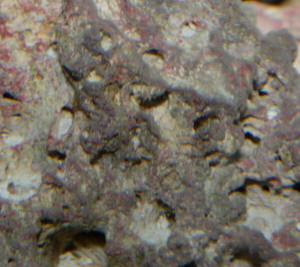 |
Unknown Polka Dot Blob?, 8/18/08 Hi all you
wonderful people! <Hello> I have been scouring images until
my eyes feel like they are going to fall out & wonder if you
can point me into the right direction... I honestly try to find it
on my own, so as not to bother you, until I give up! Was thinking
it could be a poriferan, then ascidian, tunicate, egg sac, etc. I
see a couple pieces of bubble algae real close. Can the bubble
algae turn into a polka dotted blob? Just kind of wondering if I
should scrub it off? <Is most likely a species of Botryocladia,
fairly common. Like the more common green bubble algae, it can
overgrow a tank if allowed to.> Thanks in advance for being so
darn smart - you will most likely know what it is right off the
bat! <Hardly, just happen to get a related query a few days
ago.> Judy
<Chris> |
|
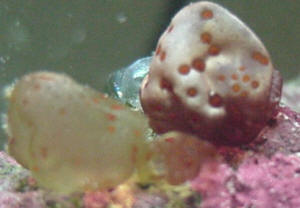
|
strange clam-like object on live rock
-08/05/08 I have a piece of Fiji live rock that has a strange
clam-looking thing attached to the inside of a hole in the rock. It
is usually partially open, but when you slightly bump it with
something it clamps tight against the rock. I have attached four
pictures...3 of it open and 1 of it closed. <Hmm, it's hard
to tell from the photos, but they look like hitch-hiker
oysters/bivalves or possibly tunicates. Please browse the following
links (and their associated ID/FAQs pages):
http://www.wetwebmedia.com/bividfaqs.htm
http://www.wetwebmedia.com/invertidfaqs.htm> I have circled it
with an orange circle. I was curious if you know what it is and if
it is harmful to my other tank inhabitants. <Seems highly
improbable that they're harmful... likely just harmless common
hitchhikers.> I have a Clarkii clownfish and a Sebae anemone in
with it. <Best,
Sara M.> |
|
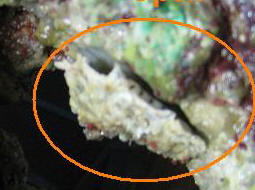 Is a bivalve. RMF Is a bivalve. RMF
|
|
Unidentified Intruder: Sponge -- 7/29/08 Hey
guys, <Hi Angie, Lynn here this morning.> I have a 125
gallon saltwater tank, have had it for two years. <Nice
size.> In December, I moved an hour away and to move it, we
tore it completely down and restarted it (our only choice).
<Bet that was fun!> I set it back up as soon as we moved
in, and have not put any livestock or plants or corals back in it
since. It only contains a few tiny snails and a random hermit
crab here and there. They are thriving on the small amount of
algae that has grown, so we aren't putting any food at all in
the tank, nor are any of the lights in the tank on at all.
<Okay> This week I have decided it's finally time to
get some fish for it, so I was doing a final cleaning and check
over, and found this in the tank. I do not remember it being
there even recently, so it had to have grown literally in the
last few days. It is white/translucent in color, is about 2-3
inches tall, and seems to be stiff, it does not wave in the
water. It has smaller "tentacle" like protrusions at
the base, as well as the one main tentacle. I am curious to see
if it is something that possibly survived the move, and the 6
months with no food and no light. <Yep, it's a
neat/harmless little sponge/Poriferan that survived and
eventually took off when conditions became favorable. They're
tough little guys that don't need light - just some current,
nutrients in the water, lack of predation, and they're happy
campers!> Previous to the move, we had a few smaller damsels,
two serpent stars, shrimp, crabs, snails, and a few Condy and
flower anemones. The Condy is what it looks like the most to me,
but I am no expert! Any idea what it could be and do you think it
will be detrimental to any fish or corals I put in it? <No
worries, it's just a neat little addition to the biodiversity
within your system. For more information, please see these links:
Second Query down, titled 'Help with Sponge ID 8/31/06':
http://www.wetwebmedia.com/spongeidfaq4.htm Query: 'Help to
Identify -- Sponge 4/19/08':
http://www.wetwebmedia.com/spgidf7.htm Here's the main WWM
page (see links at the top of the page as well)
http://www.wetwebmedia.com/sponges.htm Thanks, Angie
<You're very welcome. Take care, -Lynn>
|
|
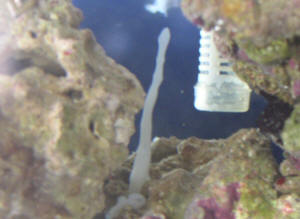
|
Green Substance, the Jimmies, now don't you hear me? ID
guessing 07/07/08 Hi! We're preparing to move our tank and have
been watching a "growth" that's dark green and frankly
looks like the ice cream "jimmies" or "sprinkles".
It started on the top spot of one of the rocks and recently another
patch showed up on another rock. I checked the Marine Atlas but
can't determine if this is algae, or what and above all else is it
something to get rid of? Thanks in advance for your help! Bill
<Perhaps a pic? Too much of a guessing game with the little info.
provided... You have read here: http://wetwebmedia.com/marinvind1.htm
at the top. Bob Fenner>
| What is this on my live rock? 07/07/08 Ok I
was moving around my larger live rock getting ready to move it to
my new 120 reef aquarium and found 7 of these things on the back
part of a rock. It came from a always dark area, and I just wanted
to make sure they are ok, and not bad. I thought it might be some
kind of mollusk, but was told to ask you. Thanks, Clint &
Ashley <Hello Clint & Ashley! Looks like some species of
Spondylus (or "thorny oyster") to me. These are cemented
(i.e., non-motile) scallops. Spondylus have a scallop-like build,
but one valve is cemented to the rock and both valves bear
spoon-like projections that trap algae and sponges and help to
camouflage the animal. Could possibly be Chama spp. though; a
similar organism known as the "jewel box oyster" though
if I recall correctly it is not a member of the oyster/scallop
order Pterioida but some sort of Veneroida. Chama spp. can be
recognised by the very deep valve cemented to the rock with a small
moveable lid-like valve on top (hence "jewel box"). I
remember seeing one of these in a reef tank my father had at home
during the 1980s. Seemed to be very hardy and lasted for years
without any specific care, though I don't offer that as expert
advice on maintenance! Cheers, Neale.> |
|
 Good guess/resp. RMF Good guess/resp. RMF
|
Black growth on coralline algae... no pix 6/22/08 Hello, <Hi there> I
have a 1.5 year old predominately SPS tank with great coralline algae growth.
Recently, some black growth has increasingly begun to appear on some of my live
rock overtaking the coralline algae. I believe I may have imported this
unwelcomed growth on a frag plug a couple of months ago. It appears as if the
coralline algae is decaying into this black growth. The entire back wall of the
aquarium which is covered with healthy coralline algae seems unaffected by this
black growth however I feel it's a matter of time before it succumbs to the same
fate. My corals do not seem affected at this time continue to thrive. Any
suggestions on what this is and how I can eradicate it? Thanks Darrell <Photos
would be of great help here... Likely this is mainly a blue-green algae
growth... Please read here:
http://wetwebmedia.com/marine/maintenance/index.htm Scroll down to Algae,
BGA... Bob Fenner
|
|

